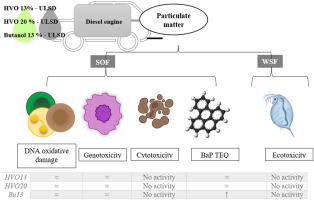Environmental Pollution ( IF 7.6 ) Pub Date : 2022-06-23 , DOI: 10.1016/j.envpol.2022.119677 Silvana Arias 1 , Verónica Estrada 2 , Isabel C Ortiz 2 , Francisco J Molina 3 , John R Agudelo 4

|
We investigated the biological response of soluble organic fraction (SOF) and water-soluble fraction (WSF) extracted from particulate matter (PM) emitted by an automotive diesel engine operating in a representative urban driving condition. The engine was fueled with ultra-low sulfur diesel (ULSD), and its binary blends by volume with 13% of butanol (Bu13), and with hydrotreated vegetable oil (HVO) at 13% (HVO13) and 20% (HVO20). Cytotoxicity, genotoxicity, oxidative DNA damage and ecotoxicity tests were carried out, and 16 polycyclic aromatic hydrocarbons (PAH) expressed as tbenzo(a)pyrene total toxicity equivalent (BaP-TEQ) were also analyzed. The Hepatocarcinoma epithelial cell line (HepG2) was exposed to SOF for 24 h and analyzed using comet assay, with the inclusion of formamidopyrimidine DNA glycosylase (FPG) and endonuclease III (Endo III) to recognize oxidized DNA bases. The WSF was evaluated through acute ecotoxicity tests with the aquatic microcrustacean Daphnia pulex (D. Pulex). Results showed that there was no cytotoxic activity for all tested SOF concentrations. Genotoxic responses by all the SOF samples were at same level, except for the HVO13 which was weaker in the absence of the enzymes. The addition of the FPG and Endo III enzymes resulted in a significant increase in the comet tail, indicating that the DNA damage from SOF for all tested fuel blends involves oxidative damage including a higher level of oxidized purines for ULSD and Bu13 in comparison with HVO blends, but the oxidized pyrimidines for HVO blends were slightly higher compared to Bu13. The WSF did not show acute ecotoxicity for any of the fuels. Unlike other samples, Bu13-derived particles significantly increase the BaP-TEQ. The contribution to the genotoxic activity and oxidative DNA from SOF was not correlated to BaP-TEQ, which means that the biological activity of PM might be affected also by other toxic compounds present in particulate phase.
中文翻译:

两种潜在中性碳柴油替代品的生物毒性风险评估
我们研究了从具有代表性的城市驾驶条件下运行的汽车柴油发动机排放的颗粒物 (PM) 中提取的可溶性有机部分 (SOF) 和水溶性部分 (WSF) 的生物响应。该发动机以超低硫柴油 (ULSD) 为燃料,其二元混合物按体积计含有 13% 的丁醇 (Bu13),以及 13% (HVO13) 和 20% (HVO20) 的加氢处理植物油 (HVO)。进行了细胞毒性、遗传毒性、氧化性 DNA 损伤和生态毒性测试,并分析了 16 种多环芳烃 (PAH),以 tbenzo(a)pyrene 总毒性当量 (BaP-TEQ) 表示。将肝癌上皮细胞系 (HepG2) 暴露于 SOF 24 小时并使用彗星试验进行分析,包含甲酰胺嘧啶 DNA 糖基化酶 (FPG) 和核酸内切酶 III (Endo III) 以识别氧化的 DNA 碱基。WSF 通过对水生小甲壳动物的急性生态毒性试验进行评估水蚤( D. Pulex)。结果表明,所有测试的 SOF 浓度都没有细胞毒活性。所有 SOF 样品的基因毒性反应都处于相同水平,除了 HVO13 在没有酶的情况下较弱。FPG 和 Endo III 酶的添加导致彗尾显着增加,表明 SOF 对所有测试燃料混合物的 DNA 损伤涉及氧化损伤,包括与 HVO 混合物相比,ULSD 和 Bu13 的氧化嘌呤水平更高,但与 Bu13 相比,HVO 混合物的氧化嘧啶略高。WSF 没有显示出任何燃料的急性生态毒性。与其他样品不同,Bu13 衍生颗粒显着提高了 BaP-TEQ。SOF 对遗传毒性活性和氧化 DNA 的贡献与 BaP-TEQ 无关,











































 京公网安备 11010802027423号
京公网安备 11010802027423号